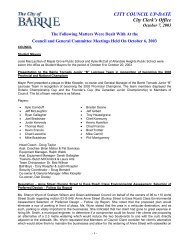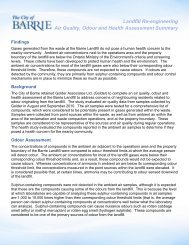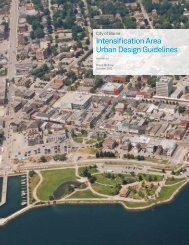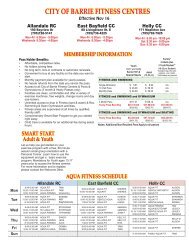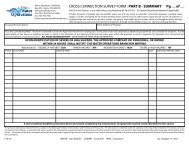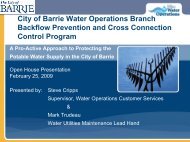APPENDIX C DETAILED SOIL CLASSIFICATION DESCRIPTIONS
APPENDIX C DETAILED SOIL CLASSIFICATION DESCRIPTIONS
APPENDIX C DETAILED SOIL CLASSIFICATION DESCRIPTIONS
Create successful ePaper yourself
Turn your PDF publications into a flip-book with our unique Google optimized e-Paper software.
C<br />
<strong>APPENDIX</strong> C<br />
<strong>DETAILED</strong> <strong>SOIL</strong> <strong>CLASSIFICATION</strong> <strong>DESCRIPTIONS</strong><br />
http://www.irda.qc.ca/Site_anglais/sols_a/arda_a.htm
Capability Classes<br />
<strong>DETAILED</strong> <strong>SOIL</strong> CLASS CODES AND <strong>DESCRIPTIONS</strong><br />
SUPPLEMENTARY TO TABLE 1<br />
Class 1-Soils in this class have no significant limitations in use for crops.<br />
Soils in Class 1 are level or have very gentle slopes, they are deep, well to imperfectly drained and have<br />
a good water-holding capacity. They are easily maintained in good tilth and productivity, and damage<br />
from erosion is slight. They are moderately high to high in productivity for a wide range of field crops<br />
adapted to the region.<br />
Class 2 -Soils in this class have moderate limitations that restrict the range of<br />
crops or require moderate conservation practices.<br />
Soils in Class 2 are deep and have a good water-holding capacity. The limitations are moderate and the<br />
soils can be managed and cropped with little difficulty. The soils are moderately high to high in<br />
productivity for a fairly wide range of field crops adapted to the region.<br />
The limitation of soils in this class may be any one of the following: adverse regional climate; moderate<br />
effects of accumulative undesirable characteristics; moderate effects of erosion; poor soil structure or<br />
slow permeability; low fertility correctable with consistent moderate applications of fertilizers and usually<br />
lime; gentle to moderate slopes; occasional damaging overflow; and wetness correctable by drainage but<br />
continuing as a moderate limitation.<br />
Soils in this class are not generally suited to as wide a range of crops as the soils in Class 1. Also more<br />
intensive conservation measures, tillage practices, or special soilconserving systems may be required.<br />
The combinations of practices vary from place to place depending on the climate, soil and regional<br />
cropping systems.<br />
Class 3 -Soils in this class have moderately severe limitations that restrict the<br />
range of crops or require special conservation practices.<br />
Soils in Class 3 have more severe limitations than those in Class 2 and conservation practices are more<br />
difficult to apply and maintain. Under good management these soils are fair to moderately high in<br />
productivity for a fairly wide range of field crops adapted to the region.<br />
In this class the limitations that restrict cultivation, ease of tillage, planting and harvesting, the choice of<br />
crops, the application and maintenance of conservation practices, are a combination of two of those<br />
described under Class 2 or one of the following: moderate climatic limitations including frost pockets;<br />
moderately severe effects of erosion; intractable soil mass or very slow permeability; low fertility<br />
correctable with consistent heavy applications of fertilizers and usually lime; moderate to strong slopes;<br />
frequent overflow accompanied by crop damage; poor drainage resulting in crop failures in some years;<br />
low water-holding capacity or slowness in release of water to plants; stoniness sufficiently severe to<br />
seriously handicap cultivation and necessitating some clearing; restricted rooting zone; moderate salinity.<br />
Each soil in this class may have one or more alternative uses or practices required for use but the<br />
alternatives may be fewer than for soils in Class 2.<br />
http://www.irda.qc.ca/Site_anglais/sols_a/arda_a.htm
Class 4-Soils in this class have severe limitations that restrict the range of crops<br />
or require special conservation practices or both.<br />
Soils in Class 4 have such limitations that they are only suitable for a few crops, or the yield for a range of<br />
crops is low, or the risk of crop failure is high. The limitations may seriously affect such farm practices as<br />
the timing and ease of tillage, planting and harvesting, and the application and maintenance of<br />
conservation practices. These soils are low to medium in productivity for a narrow range of crops but may<br />
have higher productivity for a specially adapted crop.<br />
The limitations include the adverse effects of a combination of two or more of those described in Classes<br />
2 and 3 or one of the following: moderately-severe climate; very low water-holding capacity; low fertility<br />
difficult or unfeasible to correct; strong slopes; severe past erosion; very intractable mass of soil or<br />
extremely slow permeability; frequent overflow with severe effects on crops; severe salinity causing some<br />
crop failures; extreme stoniness requiring considerable clearing to permit annual cultivation; very<br />
restricted rooting zone, but more than one foot of soil over bedrock or an impermeable layer.<br />
Class 4 soils in subhumid and some arid regions may produce good yields of regionally cultivated crops<br />
in years of high rainfall; low yields in years of average<br />
rainfall and failures in years below average rainfall. During years of low precipitation even though no crop<br />
is expected, special management practices are required to minimize wind erosion, maintain productivity<br />
and conserve moisture. These measures include emergency tillage and crops used only for the primary<br />
purpose of preventing soil deterioration. These treatments and others must be applied more frequently<br />
and more intensively than on soils in Class 3.<br />
Class 5-Soils in this class have very severe limitations that restrict their capability<br />
to producing perennial forage crops, and improvement practices are feasible.<br />
Soils in Class 5 have such serious soil, climatic or other limitations that they are not capable of use for<br />
sustained production of annual field crops. However, they may be improved by the use of farm machinery<br />
for the production of native or tame species of perennial forage plants. Feasible improvement practices<br />
include clearing of bush, cultivation, seeding, fertilizing and water control.<br />
The limitations in Class 5 include the adverse effects of one or more of the following: severe climate; low<br />
waterholding capacity; severe past erosion; steep slopes; very poor drainage; very frequent overflow;<br />
severe salinity permitting only salt tolerant forage crops to grow; stoniness or shallowness to bedrock that<br />
make annual cultivation impractical.<br />
Some soils in Class 5 can be used for cultivated field crops provided unusually intensive management is<br />
used. Some of the soils in this class are also adapted to special crops such as blueberries, orchard crops,<br />
or the like, requiring soil conditions unlike those needed by the common crops. Cultivated field crops may<br />
be grown in Class 5 areas where adverse climate is the main limitation but crop failures occur under<br />
average conditions.<br />
Class 6-Soils in this class are capable only of producing perennial forage crops,<br />
and improvement practices are not feasible.<br />
Soils in Class 6 have some natural sustained grazing capacity for farm animals but have such serious<br />
soil, climatic or other limitations as to make impractical the application of improvement practices that can<br />
be carried out in Class 5. Soils may be placed in this class because their physical nature prevents<br />
improvement through the use of farm machinery, or the soils are not responsive to improvement practices<br />
or because of a short grazing season, or because stock watering facilities are inadequate. Such<br />
improvement as may be effected by seeding and fertilizing by hand or by aerial methods shall not change<br />
the classification of these soil areas.<br />
http://www.irda.qc.ca/Site_anglais/sols_a/arda_a.htm
The limitations in Class 6 include the adverse effects of one or more of the following: very severe climate;<br />
very low water-holding capacity; very steep slopes; very severely eroded land with gullies too numerous<br />
and too deep for working with machinery; severely saline land producing only edible, salt-tolerant, native<br />
plants; very frequent overflow allowing less than 10 weeks effective grazing; water on the surface of the<br />
soil for most of the year; stoniness-or shallowness to bedrock that makes any cultivation impractical.<br />
Class 7-Soils in this class have no capability for arable culture or permanent<br />
pasture.<br />
The soils or lands in Class 7 have limitations so severe that they are not capable of use for arable culture<br />
or permanent pasture. All classified areas (except organic soils) not included in Classes I to 6 shall be<br />
placed in this class. Bodies of water too small to delineate on the map are included in this class.<br />
Class 7 soils may or may not have a high capability for trees, native fruits, wildlife and recreation. Hence<br />
no inferences can be made as to the capability of the soils and land types in this class beyond the scope<br />
of their capability for agriculture.<br />
Capability Subclasses<br />
Subclasses are divisions within classes that have the same kind of limitations for agricultural use.<br />
Thirteen different kinds of limitations are recognized at the subclass level. A brief discussion of these<br />
subclasses and their designation on maps follows:<br />
Adverse climate (C): This subclass denotes a significant adverse climate for crop production as<br />
compared to the "median" climate which is defined as one with sufficiently high growing-season<br />
temperatures to bring field crops to maturity, and with sufficient precipitation to permit crops to be grown<br />
each year on the same land without a serious risk of partial or total crop failures.<br />
Undesirable soil structure and/or low permeability (D): This subclass is used for soils<br />
difficult to till, or which absorb water very slowly or in which the depth of rooting zone is restricted by<br />
conditions other than a high water table or consolidated bedrock.<br />
Erosion (E): Subclass E includes soils where damage from erosion is a limitation to agricultural use.<br />
Damage is assessed on the loss of productivity and on the difficulties in farming land with gullies.<br />
Low fertility (F): This subclass is made up of soils having low fertility that either is correctable with<br />
careful management in the use of fertilizers and soil amendments or is difficult to correct in a feasible<br />
way. The limitation may be due to lack of available plant nutrients, high acidity or alkalinity, low exchange<br />
capacity, high levels of carbonates or presence of toxic compounds.<br />
Inundation by streams or lakes (I): This subclass includes soils subjected to inundation causing<br />
crop damage or restricting agricultural use.<br />
Moisture limitation (M): This subclass consists of soils where crops are adversely affected by<br />
drouthiness owing to inherent soil characteristics. They are usually soils with low water-holding capacity.<br />
Salinity (N): This subclass includes soils with enough soluble salts to adversely affect crop growth or<br />
restrict the range of crops that may be grown. Such soils are not placed higher than Class 3.<br />
http://www.irda.qc.ca/Site_anglais/sols_a/arda_a.htm
Stoniness (P): This subclass is made up of soils sufficiently stony to significantly hinder tillage,<br />
planting, and harvesting operations. Stony soils are usually less productive than comparable non-stony<br />
soils.<br />
Consolidated bedrock (R): This subclass includes soils where the presence of bedrock near the<br />
surface restricts their agricultural use. Consolidated bedrock at depths greater than 3 feet from the<br />
surface is not considered as a limitation, except on irrigated lands where a greater depth of soil is<br />
desirable.<br />
Adverse soil characteristics (S): On the 1:250,000 scale capability maps this subclass will be<br />
used in place of subclasses D, F, M and N either individually or collectively. On larger scale maps it may<br />
be used in a collective sense for two or more of these subclasses (see guidelines).<br />
Topography (T): This subclass is made up of soils where topography is a limitation. Both the percent<br />
of slope and the pattern or frequency of slopes in different directions are important factors in increasing<br />
the cost of farming over that of smooth land, in decreasing the uniformity of growth and maturity of crops,<br />
and in increasing the hazard of water erosion.<br />
Excess water (W): Subclass W is made up of soils where excess water other than that brought about<br />
by inundation is a limitation to their use for agriculture. Excess water may result from inadequate soil<br />
drainage, a high water table, seepage or runoff from surrounding areas.<br />
Cumulative minor adverse characteristics (X): This subclass is made up of soils having a<br />
moderate limitation caused by the cumulative effect of two or more adverse characteristics which singly<br />
are not serious enough to affect the class rating.<br />
Organic Soils*<br />
The interpretive soil capability classification is not applied to organic soils since, in general, there is<br />
insufficient information on these organic soil areas to make such an interpretive judgement.<br />
Organic soils are designated by the letter O alone.<br />
*The definition of organic soils as prepared by the National Soil Survey Committee reads as follows: Soils that<br />
contain 30 per cent or more of organic matter and have a depth of 12 inches or more of consolidated organic<br />
material..<br />
http://www.irda.qc.ca/Site_anglais/sols_a/arda_a.htm


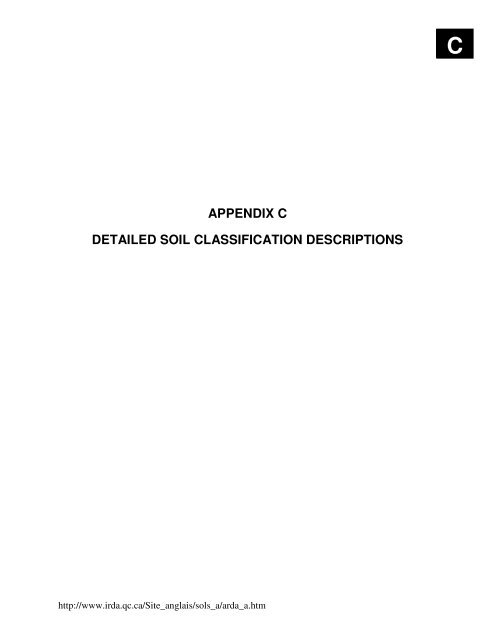
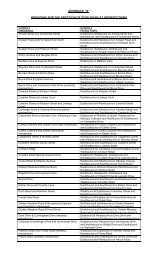


![Water Specification [DOC] - City of Barrie](https://img.yumpu.com/11698186/1/190x245/water-specification-doc-city-of-barrie.jpg?quality=85)

